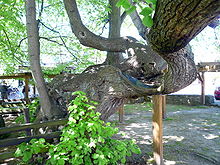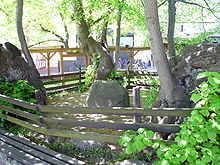Linden tree in Schenklengsfeld
The linden tree in Schenklengsfeld (also called Schenklengsfelder Dorflinde or giant linden tree ) is a so-called thousand - year - old linden tree and perhaps the oldest tree in Germany . The summer lime tree ( Tilia platyphyllos ) is in Schenklengsfeld , about ten kilometers southeast of Bad Hersfeld in the Hersfeld-Rotenburg district in East Hesse . In earlier times it still had the function of a linden tree under which court was held for several centuries . In addition, a pillory for the penal system was set up with her .
Coordinates: 50 ° 49 ′ 9 ″ N , 9 ° 50 ′ 41 ″ E
Location
The linden tree stands at about 318 meters above sea level on the market square of Schenklengsfeld, which is located on a fertile plateau between the Seulingswald in the north and the Hessian skittles in the south. The market square is slightly inclined to the south and about 30 by 60 meters in size. Today it is completely paved. The linden tree itself is surrounded by a stone wall about 50 centimeters high. A beam structure has supported the branches of the linden tree since at least 1900. The wall has several passages to the interior. Behind it is the Sankt-Georg-Brunnen.
description
The linden tree consists of four parts that give the impression of individual trees, but come from a common rootstock . In the interior between the four trunks there is a larger open area of around six square meters, raised by stones and bordered by a picket fence.
The crown of the linden tree is formed by horizontal main branches. These are supported by a 65-meter-long scaffolding that rests on a total of more than 80 beams. A few branches grow normally in the center of the crown . The unusual growth form of the horizontal main branches was achieved by spreading the crown and thus reducing the growth in height. At a height of about ten meters, the crown has a diameter of almost 25 meters. With a circumference of 120 meters, the Schenklengsfelder linden tree has the largest surviving linden roof. Historians recommend the careful restoration of the original, flat habit.
It is unclear whether the linden tree originally developed from a single tree, the trunk of which broke, or whether it emerged from four related trees that grew together to form a common rootstock. According to legend, the linden tree was split long ago by a lightning strike. At a time when the trunk was still made of one piece, beams and floorboards are said to have been on the main branches, which served as a dance platform . However, the veracity of these stories is doubted by some experts.
From other Tanzlinden it is documented that the management of the branches was used to obtain raffia for processing in apple cultivation . In this process, the young, vertical shoots of the guided linden tree were cut off. So that the branches could always be harvested in sufficient quantities, the main branches were bent down and fixed in this position. As a result, the characteristic cross-striving growth form was formed. It is not known whether the Schenklengsfelder linden tree was also cultivated.
Trunk circumference
Measuring the circumference of the trunk is difficult because the trunk consists of four separate parts. You measure around the four trunk parts, each about three meters in circumference. The missing space is not taken into account. At a height of one meter, the trunk circumference, measured in this way, is 17.91 meters. At the point of its smallest diameter, the trunk has a circumference of 17.80 meters. The linden tree thus has the largest girth of a tree in Germany. A measurement by Hartwig Goerss in 1978 showed a circumference of 17.40 meters at a height of 0.5 meters.
Age
There are various details about the age of the linden tree. "Planted in the year 760" is written on a stone in the center of the four trunk parts. This date is identical to that of the chapel building. According to this, the linden tree would be almost 1250 years old today. By whom and when the stone was attached is not known, but the year is said to have been engraved there only in the 20th century by a village school teacher at the time.
In the ARD broadcast Germany's oldest trees on April 23, 2007, the lime tree was presented by Stefan Kühn from the German Tree Archives as the oldest tree in Germany, probably 1000 years old or more. Hans Joachim Fröhlich also stated an age of over 1000 in 1990 and Anette Lenzing in 2005 from 1200 to 1300 years. In the latest literature, Germany's old trees , the age of the linden tree is given as 600 to 1000 years. The minimum estimate of 600 years comes from Bernd Ullrich, the 1000 years from documents of the German Tree Archives . A report by the time of 2012, the Tree Age 1275 years was given.
history
According to P. Rosskopf from 1964 in Das Landecker Amt in the Hersfeld district , the linden tree is said to have been planted in 760 when a chapel was built in honor of the knight Saint George , as evidenced by a stone in the center of the four trunk parts. At that time the place was still called Lengisfeld . However, the planting of the linden tree is not recorded. The linden tree served continuously from 1557 to 1796 and then until well into the 19th century at times as a court linden tree and for a long time as a meeting place for dancing and a fair .
Due to its special nature , the linden tree has long been designated as a natural monument . Based on the Field and Forest Police Act of 1880, it was already protected in 1926 and 1930 by orders of the district and local police authorities for the protection of natural monuments and in 1936 under the Reich Nature Conservation Act. In 1976 the linden tree was renovated by tree surgeon Michael Maurer for 11,000 DM . Another renovation took place on November 16, 2009 on behalf of the UNB (Lower Nature Conservation Authority of the Hersfeld-Rotenburg district) by the Gebrüder Wäldchen from Ulrichstein.
Tanzlinde
The tree surgeon Michael Maurer describes the earlier appearance and use of the linden tree in his report of September 30, 1968 as follows:
“And it is not only the Schenklengsfelder linden tree whose lower wreath of branches has been pulled out so far. Originally this linden tree was raised in three steps, even 3 steps of the ground. This is related to the classification in the Germanic faith: under the tree the giants (devils), in the tree the people and above in the third level (heaven) the sir. In addition, it was believed that the bride's dance had to be danced in the house of Freija, the fairy godmother, in order to bring luck. Certainly this linden tree was once three-tiered. Just like on the famous Effeltrich linden tree [...] the middle trunk withered due to the excessive extraction of the lowest level, it starved and died from above. Certainly 200 years ago people danced upstairs, later downstairs. "
Court linden tree
In Schenklengsfeld civil servants exercised the office of judges continuously from 1557 to 1796 and then at times until well into the 19th century. The former office building at Landeckerstraße 8, located near the linden tree, was the seat of the landgrave-Hessian bailiff , the chief judge of the Landecker office . Under the Gerichtslinde by were Charlemagne introduced councils as a Thing or Rügegericht held. The convicted field violators were chained to a stake under the linden tree for one or more hours, sometimes for one or more days. This is evidenced by the discovery of a lock iron with which the condemned were attached to the pillory. Hartwig Goerss wrote about it in 1981:
“In earlier times the complaint courts [...] took place under the linden tree. [...] were held by the community council and had the purpose of condemning the criminal offenders. These wrongdoers [...] were connected to a post (Löngestock) attached under the linden tree, on which there was a lock iron, for one or several hours, often a whole day. "
Today's meaning
The dance meeting has survived to this day and is celebrated every two years in June as a linden blossom festival. They show costume groups , choral societies and historical pageants scenes from history. As a highlight, the linden tree is illuminated by fireworks at the end of the festival . The linden tree is one of the sights of the municipality.
See also
literature
- Bernd Ullrich, Stefan Kühn, Uwe Kühn: Our 500 oldest trees: Exclusively from the German Tree Archives . BLV Buchverlag GmbH & Co. KG, Munich 2009, ISBN 978-3-8354-0376-5 , p. 152 .
- Anette Lenzing: Court linden trees and thing places in Germany. Verlagbuchhandlung KG, Königstein im Taunus 2005, ISBN 3-7845-4520-3 .
- Stefan Kühn, Bernd Ullrich, Uwe Kühn: Germany's old trees. Fifth, expanded edition, BLV Buchverlag GmbH & Co. KG, Munich 2007, ISBN 978-3-8354-0183-9 .
- Hans Joachim Fröhlich : Paths to old trees - Volume 1, Hessen. Widi-Druck, Offenbach 1990, ISBN 3-926181-06-0 .
- Hans Joachim Fröhlich: Old lovable trees in Germany. Cornelia Ahlering Verlag, Buchholz 2000, ISBN 3-926600-05-5 .
- Hartwig Goerss: Our tree veterans. Landbuch Verlag, Hannover 1981.
- Michael Brunner: Important linden trees - 400 giant trees in Germany. Haupt Verlag, Bern, Stuttgart, Vienna 2007, ISBN 978-3-258-07248-7 .
- Johannes Hesse: Our Linde brochure about the 1000 year old Linde in Schenklengsfeld 2014
Individual evidence
- ^ Hessisches Staatsarchiv, Marburg - files from the 17th century.
- ↑ a b c d e f g Anette Lenzing: Judicial linden trees and Thing places in Germany. P. 74.
- ↑ Graefe, Rainer: Buildings from living trees: guided dance and court linden trees . Geymüller, Verl. Für Architektur, Aachen 2014, ISBN 978-3-943164-08-4 , p. 108 f .
- ↑ a b c d Hans Joachim Fröhlich : Old lovable trees in Germany. P. 157. See also: Literature.
- ↑ a b Stefan Kühn, Bernd Ullrich, Uwe Kühn: Germany's old trees. P. 14.
- ↑ Stefan Kühn, Bernd Ullrich, Uwe Kühn: Germany's old trees. P. 190.
- ↑ The 1000-year-old Tanzlinde in Schenklengsfeld at altebaeume.de
- ↑ Der Spiegel , No. 27, June 29, 2020.
- ^ DasErste.de : Germany's oldest trees ( Memento from September 27, 2007 in the Internet Archive )
- ↑ Map of Germany: The oldest trees on zeit.de, accessed on February 16, 2014
- ^ A b Anette Lenzing: Judicial linden trees and Thingplaces in Germany. P. 75.
- ↑ Famous "Tanzlinde" in Schenklengsfeld needs arboriculture. (No longer available online.) In: Press release- Hessen.de online magazine. Archived from the original on March 4, 2016 ; Retrieved February 3, 2010 . Info: The archive link was inserted automatically and has not yet been checked. Please check the original and archive link according to the instructions and then remove this notice.
- ↑ On this also a report in the Hessenschau
- ↑ Maurer tree care from the archive of the district office for nature conservation and landscape maintenance in Bad Hersfeld
- ↑ Hartwig Goerss: Our tree veterans. P. 79.
- ^ Linden tree near the community of Schenklengsfeld






